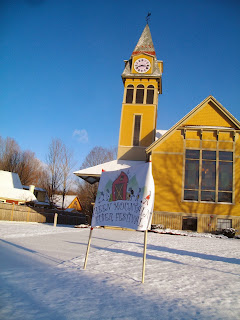While looking into the history of pottery making in the Mid-West, Minnesota area, I am discovering some interesting things.
+earliest+pottery+in+Minnesota+built+in+1860.jpg) |
St Anthony Pottery, built by Kampff in 1860
probably the first pottery in Minnesota* |
 |
| This is where the Kampff potter was... but no longer. |
Immigrants from Germany and westward movers from New York State and New England, were just getting out here to Minnesota in 1850s. Perhaps the first potter in Minneapolis was Louis Kampff, from Hanover, Germany. He came to St. Anthony area of Minneapolis, built a long shed to work at making pottery in 1857 and then replaced it with a stone, 2 story factory in 1860. He hired at least two employees, and began to make flower pots, garden vases and other terra- cotta wares. He used the red clay he found on his site.
I found another early potter who settled in the Red Wing area a few years before the famous Red Wing Pottery factory in Red Wing, Minnesota was built. Joseph Pohl from Germany worked at pottery along with farming in a small turf covered shop on a treadle wheel using clay from his property. He made flower pots and crockery for his neighbors. The history books say he used stone ware clay, but the flower pots were probably red clay. The day I found the pottery site, the undergrowth in July was too dense to go digging around for clay... next time. Minnesota has large amounts of red earthenware and buff stoneware clays.
 |
| Joseph Pohls pottery site... somehow his name got Americanized to John Paul |
 |
| "John Paul's" clay pit with prickly brush on the side of a dirt road. |
 |
| The story of the "John Paul" pottery and clay pit is told on a plac on Route 58 to Red Wing. |
Chaska, a few miles south west of Minneapolis, made thousands of yellow bricks with clay dug out of pits, and yet red clays line the Minnesota river that runs nearby. I counted 7 potteries in the Minneapolis area by 1860. For the small population in the area and the time period (they were on the verge of industrial America), these 7 potteries made a lot of wares. The rail roads were being built and used at that time for transporting wares to other parts of the county. Transportation is one of the big changes from our small New England potteries that were produced by a family and some apprentices and sold to local folks, to the mass production that began around 1860 in factories that supplied thousands of pots per week across the county by freight.
 |
| Chaska Brick men, Minnesota |
Chaska today has at least four large "ponds" formed by rain filling in the clay pits. I dug up a handful. Nice yellow color.
 |
| Chaska. Those ponds are actually clay pits... still full of nice yellow clay. |
Red Wing Pottery is the most famous pottery in the area for its crocks and jugs.
The 70 gallon jug at left was specially made for display at
the 1923 Minnesota State Fair. It is one of only three made and is the only one
known to have survived. The jugs survival is an amazing story in itself. In
1994, the 70 gallon behemoth was found partially buried in a barn on the Turec
estate in Milligan, NE. Mr. Turec collected steam engines and the story goes, he
took a trip to Minnesota to buy a steam engine and saw this jug.
One version of the story has him buying the jug for 50 cents.
The second version has Mr. Turec being asked to take the jug if he wanted the
steam engine. Either way that’s how it ended up in Milligan. When the jug was
sold at auction the bidding was quite fierce, but Jerry prevailed and was
fortunate enough to keep the jug in Nebraska.
Compared to us in New England where potters started using the red clay near Boston, MA when they stepped off the boat from England in 1627, the potteries starting up in Minnesota were modern.
Industrial America wiped out the small time potters who had been working their trade for 250 years in America.
The mid-westerners jumped into the industrial age while the American Indian was still fighting for their land.

The clay is still there. Most of the big potteries and brick yards are gone. Americans can now buy pottery cheaper from China and beautiful brick buildings are replaced by concrete and metal.
Progress.
*http://www.streets.mn ... streets of Minneapolis then and now.















































+earliest+pottery+in+Minnesota+built+in+1860.jpg)









